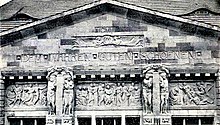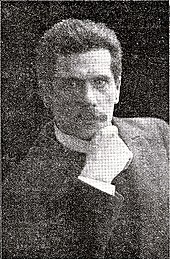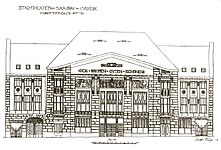Lübeck Theater
|
|
The Theater Lübeck (formerly: Bühnen der Hansestadt Lübeck or City Theater for short ) is operated by the Lübecker Theater gGmbH , a company of the Hanseatic City of Lübeck . It is one of the large urban theaters in northern Germany.
building
Interest in drama and opera only awoke in Lübeck in the course of the Enlightenment . The first opera was performed on June 2, 1746 in the house of the carpenter Schröder at the corner of Königstrasse / Wahmstrasse . The previous building of today's theater from 1752 and the relationship between the ensemble and the urban bourgeoisie in the 19th century are described in detail by Thomas Mann in his Buddenbrooks and by Ludwig Ewers in his grandfather city .
A new theater building commission was formed in 1905/06 to rebuild the theater. Senators Johann Hermann Eschenburg , Eugen Emil Arthur Kulenkamp and Julius Vermehren were appointed to the commission from the Lübeck Senate , and Johannes Daniel Benda , August Sartori (pedagogue) , H. Blunck, Heinrich Görtz , HW Behn, HL Ms. Stender and Hermann from the Citizens Committee Otte elected. In addition, building director Johannes Baltzer and building officer Eugen Deditius were on the commission. The new building laws of 1919, the preparatory work of which went back to 1906, were Deditius' main work in later times.
Martin Dülfer , the winner of the tender, had once worked in the studio of one of the judges, Karl von Großheim . He also designed and realized theaters in Meran, Duisburg and Sofia.
The theater in Lübeck's old town was rebuilt in Art Nouveau style by the Dresden architect Prof. Martin Dülfer and his local site manager Max Baudrexel in Beckergrube 10-14 with the help of donations from the patron Emil Possehl , and opened in October 1908. It replaced the previous building from 1859, the so-called casino theater. Today's Great House originally had 970 seats and standing space for up to 78 (see illustrations).
The reliefs in the main cornice of the sandstone facade are the work of the sculptor Georg Roemer . The middle field shows Apollo and the nine muses , with comedy and tragedy on each side . The group of caryatids and atlases carrying the gable triangle is the work of the Hamburg-based sculptor Karl Weinberger .
From 1918 to 1933 the closure of the theater and in connection with it the merger with Kiel, Rostock or Schwerin was discussed in the citizenship. Since the merger with Kiel did not result in any savings and the fact that Rostock proved to be too expensive because of the railway tariffs, these were put aside.
In 1925 the ballroom on the first floor of the theater was rebuilt. The Kammerspiele have been located there ever since.
In 1937/38 another interior renovation took place, during which a large part of the decorative Art Nouveau elements were lost.
In 1965, a studio stage with up to 99 variable seats was created for the theater for children and young people in the theater's former dining room.
In the years 1992 to 1996 the building was "completely renovated". The Art Nouveau ornaments inside the building were reconstructed, especially the ceiling of the Great House. In favor of fire protection and modern technology, around 170 seats were dispensed with. Since then, the building has presented itself as a clear theater building from the Art Nouveau era.
- The old city theater (casino)
- New city theater
theatre
Today the Lübeck Theater combines three stages in one building. In the large house (around 800 seats), a 300 m 2 stage plus an orchestra podium and extensive stage machinery will be used. In the Kammerspiele (around 320 seats) there is a stage with 154 m 2 of stage area. The range originally comprised the three classic categories. After ceasing its own dance theater ( ballet ) due to austerity measures, it offers music theater and drama as well as concerts by the Philharmonic Orchestra in the Great House , the Kammerspiele and in the Junge Studio . Henry Vahl , Horst Frank and Joachim Hermann Luger were part of the theater's ensemble . There are regular performances by the Low German Stage, the children's and youth theater, the Lübeck Pocket Opera and projects in the field of theater education.
orchestra
The Philharmonic Orchestra of the Hanseatic City of Lübeck was founded in 1897 by the Verein der Musikfreunde Lübeck . In addition to the nine annual symphony concerts as well as several chamber concerts, special and extra concerts, the Lübeck Philharmonic as well as the choir and extra choir of the Lübeck Theater have significantly determined the sound profile of the music theater at the Lübeck City Theater, to which they are organizationally assigned, since 1908. The orchestra's concerts are now perceived as the "new" third division of the house. The Philharmonic Orchestra of the Hanseatic City of Lübeck, as a B-orchestra with 70 musicians, is an ensemble with diverse connections to Lübeck and now the Hamburg metropolitan region. Thanks to the Possehl Foundation , the orchestra academy and the international elite opera studio enable close cooperation with the Lübeck University of Music by integrating young soloists into the theater for one season while studying.
The orchestra's early conductors were Hermann Abendroth (1905–1911), Wilhelm Furtwängler (1911–1915) and Eugen Jochum (1928/29). From 1933 to 1945 Furtwängler and Abendroth were to come to terms with National Socialist rule elsewhere. In Lübeck, too, from 1933 to 1945, as in other places, people and works were ostracized and forgotten.
In the post-war period, the Philharmonic Orchestra in Lübeck shaped the conductors Christoph von Dohnányi (1957–1963), Gerd Albrecht (1963–1966) and Bernhard Klee (1966–1973). In the more recent and recent past Erich Wächter (1989–2001), Roman Brogli-Sacher (2001–2012), Ryusuke Numajiri (2013–2017) and Andreas Wolf (2017–2019 acting GMD) promoted the development and appreciation of the Hanseatic City's Philharmonic Orchestra .
With Stefan Vladar , a conductor and pianist took up the post of general music director in 2019, who gave his inaugural concert with the musicians of the orchestra and the singers of the choirs in the concert hall.
Since the founding of the orchestra by the Verein der Musikfreunde, the former hall building in Fünfhausen and the former casino theater, then the large house in today's theater building, and after the Second World War, the hall in the Colosseum was initially used for concerts.
In 1994, the Philharmonic Orchestra of the Hanseatic city of Lübeck referred as new concert hall by the architect Meinhard von Gerkan designed Music and Congress Center Lübeck . The hall's concert hall has 1900 seats and offers excellent acoustics. Today, the members of the Philharmonic Orchestra and visitors make sound experiences together in different concerts in different places in the city in freedom and variety: During the concerts in the music and congress hall, in the Great House during the performances of the music theater, during the chamber concerts e.g. B. in the museums, in the library, in the town hall and in the churches of the old town.
organization
The actor Stanislaus Fuchs from 1911–1918 was a key director of the Lübeck City Theater in the early days .
After the end of World War II , directors were Friedrich Siems (1945–1947), Hans Schüler (1947–1951), Christian Mettin (1951–1959), Arno Wüstenhöfer (1959–1964), Walter Heidrich (1964–1968), Karl Vibach ( 1968–1978), Hans Thoenies (1978–1991), Dietrich von Oertzen (1991–2000) and Marc Adam (2000–2007).
In 2007 the management structure of the theater was changed and expanded into a directorate through artistic divisional management. Since then, members have been Roman Brogli-Sacher, Ryusuke Numajiri, Christian Schwandt, Dr. Katharina Kost-Tolmein.
As of August 2020, the management board of the house will consist of Caspar Sawade (managing theater director), Stefan Vladar (general music director and commissioner opera director) and Pit Holzwarth (drama director).
The Hanseatic City of Lübeck holds 62.5 percent of the shares in Theater Lübeck non-profit company with limited liability , 12.5 percent each is held by the district of Northwest Mecklenburg , the Kaufmannschaft zu Lübeck and Gesellschaft der Theaterfreunde e. V. Lübeck.
The budget of around 25 million euros ( as of 2019 ) is mainly financed by grants of a similar amount from the Hanseatic City of Lübeck and the municipal financial equalization scheme in Schleswig-Holstein, as well as own revenues.
The number of visitors was most recently around 180,000 in the 2018/19 season.
The DVD edition of a new production of the Ring des Nibelungen at Theater Lübeck was awarded the ECHO Klassik 2012 as DVD music production of the year.
literature
- Heinrich Asmus: The dramatic art and the theater in Lübeck. A contribution to the history of German theater . Von Rohden, Lübeck 1862.
- Friedrich Bruns , Hugo Rahtgens , Lutz Wilde : The architectural and art monuments of the Hanseatic city of Lübeck. Volume I, Part 2: City Hall and public buildings of the city. Max Schmidt-Römhild, Lübeck 1974, pp. 379-385, ISBN 978-3-7950-0034-9 .
- Klaus Matthias: Large buildings in downtown Lübeck after 1900. From overcoming historicism to Art Nouveau . In: The car . 1992, p. 182–205 (p. 193 ff. On the architecture and pictorial program of the facade).
- Carl Stiehl : History of the theater in Lübeck . Borchers, Lübeck 1902.
- Sidney Smith, Katharina Kost: Theater Lübeck. History, rooms, highlights, people. The 100th season in Martin Dülfer's Art Nouveau building . Ed .: Theater Lübeck. Schmidt-Römhild, Lübeck 2008, ISBN 978-3-7950-1288-5 .
- Günter Zschacke : Decades that sounded - The Lübeck Philharmonic 1997-2017 , Schmidt-Römhild, Lübeck 2017
See also
Web links
Individual evidence
- ↑ Local Notes. , in: Lübeckische Blätter , Volume 48, No. 1, edition of January 7, 1906, p. 12.
- ^ Secret building officer Prof. Carl von Groszheim. In: Father-city sheets. Born 1910, No. 44, issue of October 23, 1910.
- ↑ 100 Years of the City Theater - The Opera Lover
- ^ Helmut Weihsmann: Building under the swastika: Architecture of the downfall. Promedia, Vienna 1998, ISBN 3-85371-113-8 , p. 621
- ^ Wolfgang Chechne : Lübeck and his theater. The story of a great love. Reinbek 1996, p. 99.
- ^ Companies of the Hanseatic City of Lübeck (municipal share at least 50%) In: The Citizenship of the Hanseatic City of Lübeck - Tasks, Organization, Contacts of the Hanseatic City of Lübeck, Office of the Citizenship, March 2006, p. 40.
- ↑ Lübecker Nachrichten of June 20, 2019
- ↑ Award for Der Ring des Nibelungen ( Memento of the original from July 14, 2012 in the Internet Archive ) Info: The archive link has been inserted automatically and has not yet been checked. Please check the original and archive link according to the instructions and then remove this notice. on echoklassik.de
Coordinates: 53 ° 52 ′ 11 " N , 10 ° 41 ′ 11" E













